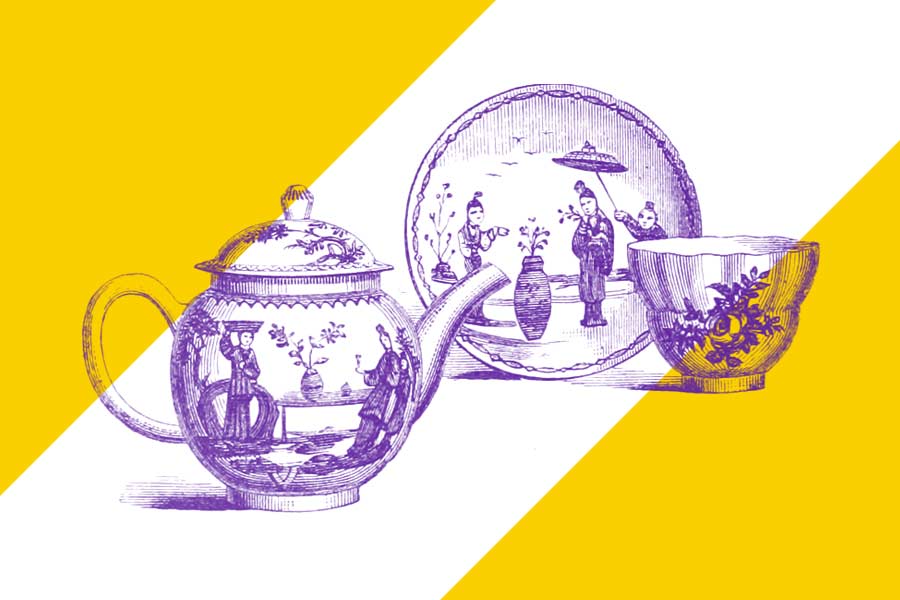Tea enthusiasts from around the world appreciate the soothing quality, unique flavor, and myriad health benefits their favorite drink has to offer. Less commonly appreciated, however, is the rich stories and history behind every cup of this timeless beverage. From the black, green, purple, red, and white teas, to flavorful and aromatic herbal teas, your favorite variety of tea has come a long way through both time and space to reach your cup today. A good cup of tea goes well with a good story, so let’s explore the origins of this monumental drink starting with its legendary roots, centuries ago in the eastern part of China.
The Father of Chinese Medicine
It was 2700 B.C. when the father of Chinese medicine, Shen Nong, experimented with various plants in eastern China. As the story goes, he was poisoned 72 times when he experimented with 72 different types of plants for their medicinal value. As a tea leaf fell into his cup of water, he drank it, and realized that it cured him from those poisonous plants. Soon after, tea was being manufactured and sold for a very expensive price, although only the wealthiest of families were able to afford it.
From Legend to the Table
The Zen monk Elsai brought seeds from China to Japan 800 years ago, although some legends say that this took place 5,000 years ago. In Taiwan, tea became popular 400 years ago, while countries like India and Africa’s largest production of tea took place around 250 years ago. Europe, North America, and Australia began growing green tea around 300 years ago, but the drink wasn’t popular in these regions until the late to mid 1800’s. When Sri Lanka’s coffee crops were ravaged by disease and nearly driven to ruin, they were replaced by fields of tea for export to other countries. An advertisement dated to 1658 spoke of England’s famous green tea, and in the United States, it was the early 20th century before tea bags were manufactured.
Camellia Sinensis, the Tea Plant
Over three quarters of the world’s tea production today is grown on tea plantations in Sri Lanka, Kenya, China, and India. Camellia Sinensis is a flowering evergreen shrub that thrives best in hot, humid types of climates. The shrub’s leaves are picked off by hand in groups of 2 or 3, with the tender buds included. The most tender leaves are widely used in black teas and sold around the world. Black tea was discovered during transportation, when oxidation caused the leaves to darken in color.
White Tea’s Origin
It was because of the Chinese Emperor Hui Zong that white tea gained popularity. During the Ming Dynasty, sometime between the mid 1300’s and the mid 1600’s, Hui Zong searched for the perfect white tea. As a result of his intense search, the country suffered great financial loss. In the end, his search proved to be wise as white tea became incredibly popular soon after. Realizing that China could grow and distribute their tea for a profit internationally, they began doing just that, causing white tea to overtake the less popular green tea in the process.
The Han Dynasty and Pu-Erh Tea
Pu-Erh is a form of tea that is dried and easily pressed into cakes. For greater ease in transporting, this type of tea was developed between the years 25 and 225 during the Han Dynasty. As the years passed by and transportation methods were updated, the popularity of Pu-Erh died down, but it became popular once again in several Asian countries between the early 1800’s and the late 1900’s.
The Story of Black Tea
As noted before, black tea came about as the English found that the leaves were oxidized during transport, causing the tea to darken in color. The English Tea Trade was a direct result of the high cost of purchasing tea from China. Because of their interest in cornering the market for exportation of tea, they began to trade it for other necessary commodities.
Kenya’s Tea Research Institute and Purple Tea
The Kenya Tea Research Institute began to produce a new tea after its black tea market slowed down. It was 30 years ago that purple tea was developed using an increase in the amount of anthocyanin in it’s leaves. Commercially, purple tea has not gained in popularity like green and black tea.
The Flavorful, Aromatic Herbal Tea
Herbal teas continue to be a favorite amongst tea enthusiasts. Highly popular during the last 40 years, they are often known as a natural medicine that soothes the soul, relaxes the body, and calms the nerves. Herbal teas are made from a wide variety of plants, but since they don’t make use of Camellia Sinensis, they are technically not really teas at all.
Red Tea, also Known as Rooibos
Red tea, or rooibos, doesn’t come from the Camellia Sinensis plant either, although preparation methods are the same as other types of tea. No one is really certain when rooibos came about, but the story goes that the Swedish discovered it during the 1700’s. Explorers brought rooibos back to the western countries, where it became popular as a decaffeinated tea. In the United States, since the early 1990’s, rooibos has joined the line of popular varieties of tea.
Science has a Story Too
The actual Camellia Sinensis plant originated in the eastern part of China, where it was used to make green tea. The popularity of a variety of teas grew internationally from there with the help of Chinese legends, a variety of advertisements, and stories of countries like Sri Lanka, Taiwan, India, Europe, and North America. Scientists have a different story to share than these Chinese legends, however. They have discovered what they believe to be tea in the tomb of a Chinese emperor that was sealed over 2,000 years ago. In fact, they believe that tea was already being used as food and not as medicine. Nowadays, tea continues to be highly popular, no matter where it comes from. As a matter of fact, most varieties are popular world wide, whether they are green, black, white, purple, red, or herbal.






